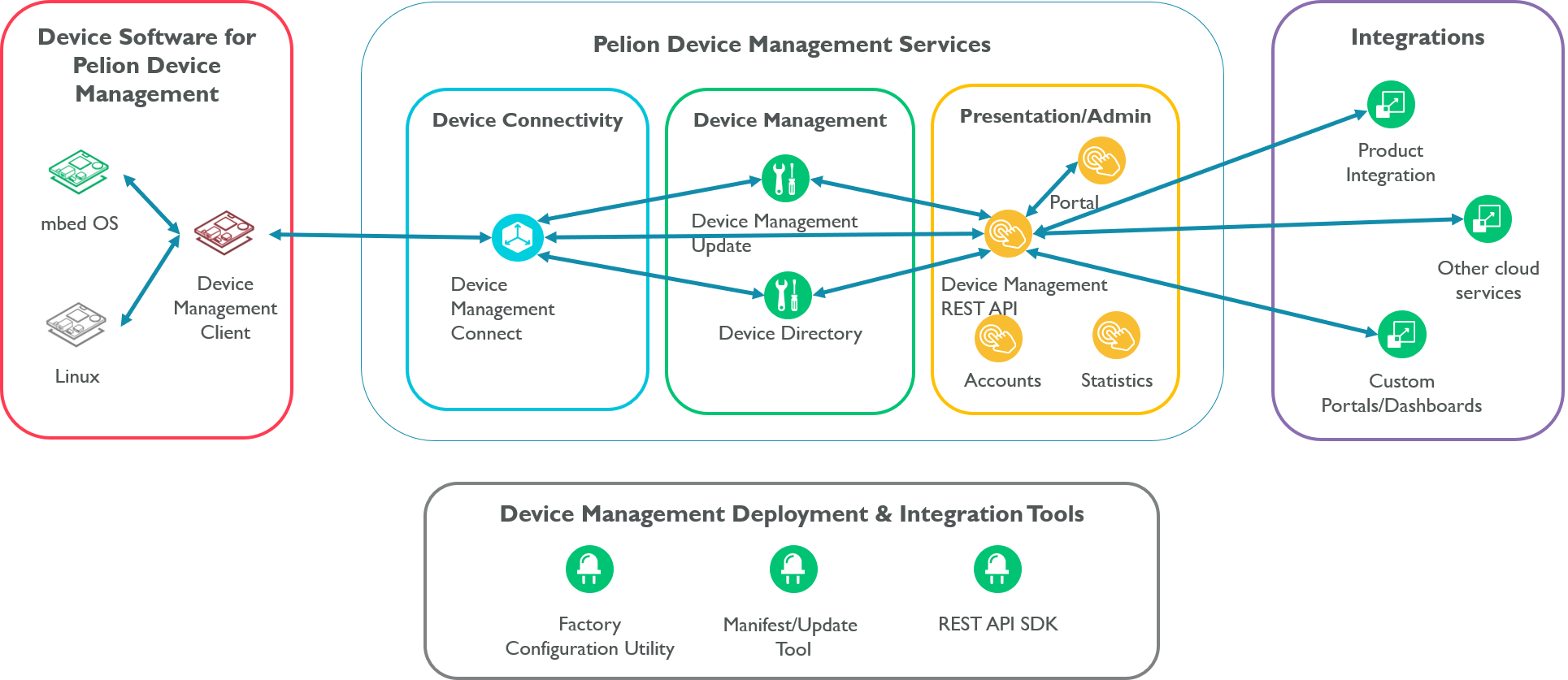Introduction to Pelion Device Management
Pelion Device Management is a managed service for interacting and managing your connected devices. It includes:
- A secure connection, over which you can interact and manage your IoT devices.
- An end-to-end remote firmware update solution.
- Distinct workflows and configurations to ease your development process, with a seamless transition into deployment.
- A flexible provisioning mechanism that can work with any factory setup to give your device all the information it needs to connect to Device Management.
- Web application development using a choice of interfaces: REST APIs, Software Development Kits (SDKs), and an online portal.
- Clients purpose-built to support Device Management services on your devices, for multiple operating systems.
Get started quickly
Try our quick connect guide for your first cloud-connected application and the update flow.
System diagram

Managing and interacting with devices
To offer an end-to-end solution, Pelion includes both the cloud-side services and the device-side clients. The cloud-side services are known as Pelion Device Management services. The device-side clients make up Device Management Client.
Device Management Client has three components, each supporting a cloud service or group of services:
- Device Management Connect client: provides a connection to Device Management servers, and therefore underpins all connectivity and management activities.
- Device Management Update client: accepts and manages installation of firmware updates.
- Device Management Provision client (factory configurator client): saves provisioning information to the device; this information includes device credentials, server URIs and other parameters that the device must have to be able to connect to your account. This element of the client is used in the factory and removed before shipping.
The Device Management Connect service is a secure and energy efficient communication service connecting devices to Device Management. It uses standards-based protocols (OMA LwM2M, CoAP, and TLS/DTLS), designed specifically for low-power devices, to enable you to communicate with the device, view its resources and receive notifications from it.
Device Management stores your devices on the Device Directory service, so you can search and manage them. You can view:
- Static information, such as the device type.
- Dynamic information, such as the firmware version.
- Custom attributes that you create and assign to the device.
- Logs of key events in the device's life cycle, such as the date of first registration with Device Management, firmware updates and status changes.
The account management services are administrative; they control your account so you can manage users, sub accounts, API keys and certificates.
APIs, SDKs and the portal
The Device Management REST APIs give your servers access to all Device Management services and the devices connected to them. The API is based on the RESTful paradigm: it exposes a concrete and consistent view of API resources, with support for CRUDL operations and HTTP requests and responses.
Note: The API hostname for Japan is not the same as the one used in the Service API documents. It is https://api.ap-northeast-1.mbedcloud.com.
You can use the Device Management Software Development Kits (SDKs) to integrate your application with the Device Management APIs without directly using either the APIs or the portal.
The Device Management Portal is a web-based interface with the Device Management APIs. You can perform many common functions, such as running update campaigns and generating certificates, but if you want an advanced integration, you will need to use the APIs, or preferably the SDKs.
Note: The portal URL in Japan is not the same as the one used throughout this documentation. It is https://portal-jp.mbedcloud.com.